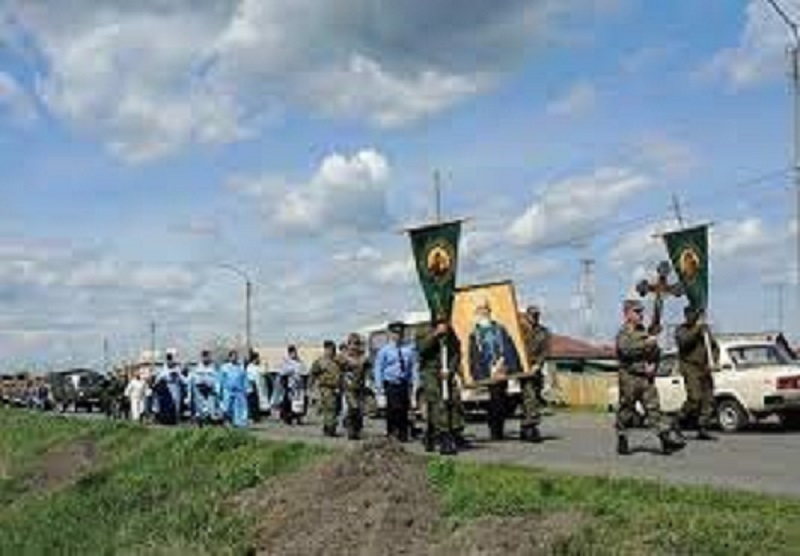Nizhny Novgorod, the Frontier Pilgrimage
In the border region between Russia and Western Kazakhstan, celebrations resume after pandemic under the banner of St George the Victorious and war symbolism. The pilgrimage commemorates the rebirth of Russia after the Tatar-Mongolian yoke and the integration of European and Asian Russians.
Moscow (AsiaNews) - The traditional Orthodox pilgrimage to the territory of the region of Nizhny Novgorod on the border with western Kazakhstan took place over the past few days, passing through the four provinces of Kupinsk, Čistoe Ozero, Bagansk and Karasuk, the latter being the seat of Bishop Filipp (Novikov) who also bears the title of Ordynsk, "bishop of the Horde". This is in fact an area linked to the reminiscences of the Tatar Hordes, which had settled between the Volga and the Urals to control the territory of occupied Russia.
The pilgrimage thus recalls the rebirth of Russia after the Tatar-Mongolian yoke, and also the integration between European and Asian Russians, a particularly topical theme today in the context of Russia's military and imperialist passions, which have direct references to the Kazakh border territories.
The eparchy of Karasuk, which in Tatar means 'small river', extends around the banks of the river of the same name, and historically would also have jurisdiction over part of the Kazakh territory, not far from the large republic of Russian Tatarstan. The episcopal see was created while still under Horde rule, to enshrine the alliance between the Asian invaders and the Orthodox Church, the factor that allowed the Rus' to survive.
This year, war symbolism also prevailed in Orthodox devotion, and the pilgrimage, resumed after a three-year interruption due to the pandemic, was dedicated to the memory of St George the Victorious, along with the feast of 'Frontier Guards Day'. Bishop Filipp had the group of faithful led by the hieromonac Melkhizedek (Svistelin), the main military chaplain of the diocese, and the prayers were attended by deployed border soldiers, who were given a special blessing.
Karasuk is at the extreme edge of the Nizhny Novgorod region, from which it is almost 700 kilometres away, in an area of not only ethnic but also religious mixture: old believers persecuted by the tsars and patriarchs took refuge here, and several pagan cults of Asian origin still survive.
The dragon-slaying martyr saint therefore inspired the 'new rebirth of the authentic Orthodox faith', as Father Melkhizedek said, wishing the soldiers 'great strength in the glorious defence of the homeland', which the entire population must join.
All soldiers were then given an icon of St George together with an image of Our Lady of Kazan, inspirer of Ivan the Terrible's victory over the Tatars, and the latest issue of the diocesan magazine "Our Eparchy", dedicated to the reasons for the pilgrimage. At the stop in Čistoe Ozero, the 'Pure River', another solemn ceremony was held in honour of a saint of local origin, the monk Ilya of Murom, who died in 1188 at the Lavra of the Kiev Caves. His name is associated with the byline, legendary stories of the bogatyr, the ancient Rus' fighter against all invading peoples,
In the village of Blagoveščensk ("of the Annunciation"), prayers were addressed directly to Our Lady "victor" of Kazan, and Father Melkhizedek held a wide-ranging conversation with the pilgrims in the town hall, answering questions and explaining the "important things" that are happening in these times of rebirth in Great Russia, assisted in this by the head of the border guards, General Sergei Groskraits.
The concluding liturgy of the pilgrimage to Karasuk was presided over by Bishop Filipp, who thanked the border guards, reminding them that "your service requires great professional training, spiritual steadfastness, fidelity to duty and the oath you have taken. You not only express love for your people, but you bear witness to one of the greatest commandments of the Gospel, Blessed is he who lays down his life for his friends'. All the concelebrating clergy wore green vestments, as the celebration booklet explains, "in honour of the traditional colours of the border guards, which are also the colours of the Karasuk municipal flag".
12/02/2016 15:14







.png)










